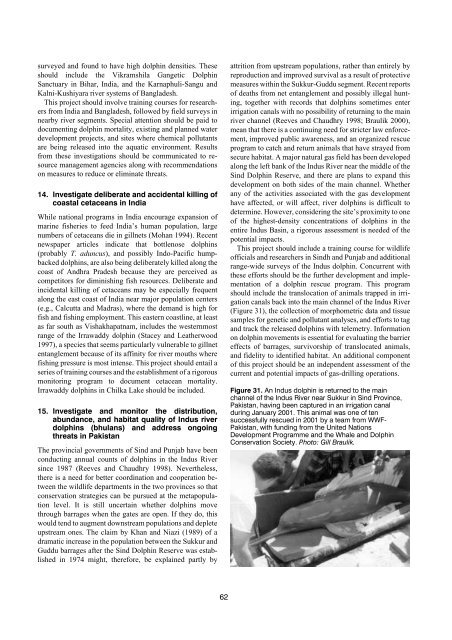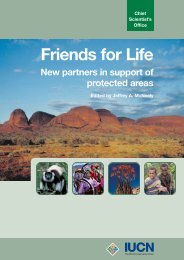Dolphins, Whales and Porpoises: 2002-2010 Conservation - IUCN
Dolphins, Whales and Porpoises: 2002-2010 Conservation - IUCN
Dolphins, Whales and Porpoises: 2002-2010 Conservation - IUCN
You also want an ePaper? Increase the reach of your titles
YUMPU automatically turns print PDFs into web optimized ePapers that Google loves.
surveyed <strong>and</strong> found to have high dolphin densities. These<br />
should include the Vikramshila Gangetic Dolphin<br />
Sanctuary in Bihar, India, <strong>and</strong> the Karnaphuli-Sangu <strong>and</strong><br />
Kalni-Kushiyara river systems of Bangladesh.<br />
This project should involve training courses for researchers<br />
from India <strong>and</strong> Bangladesh, followed by field surveys in<br />
nearby river segments. Special attention should be paid to<br />
documenting dolphin mortality, existing <strong>and</strong> planned water<br />
development projects, <strong>and</strong> sites where chemical pollutants<br />
are being released into the aquatic environment. Results<br />
from these investigations should be communicated to resource<br />
management agencies along with recommendations<br />
on measures to reduce or eliminate threats.<br />
14. Investigate deliberate <strong>and</strong> accidental killing of<br />
coastal cetaceans in India<br />
While national programs in India encourage expansion of<br />
marine fisheries to feed India’s human population, large<br />
numbers of cetaceans die in gillnets (Mohan 1994). Recent<br />
newspaper articles indicate that bottlenose dolphins<br />
(probably T. aduncus), <strong>and</strong> possibly Indo-Pacific humpbacked<br />
dolphins, are also being deliberately killed along the<br />
coast of Andhra Pradesh because they are perceived as<br />
competitors for diminishing fish resources. Deliberate <strong>and</strong><br />
incidental killing of cetaceans may be especially frequent<br />
along the east coast of India near major population centers<br />
(e.g., Calcutta <strong>and</strong> Madras), where the dem<strong>and</strong> is high for<br />
fish <strong>and</strong> fishing employment. This eastern coastline, at least<br />
as far south as Vishakhapatnam, includes the westernmost<br />
range of the Irrawaddy dolphin (Stacey <strong>and</strong> Leatherwood<br />
1997), a species that seems particularly vulnerable to gillnet<br />
entanglement because of its affinity for river mouths where<br />
fishing pressure is most intense. This project should entail a<br />
series of training courses <strong>and</strong> the establishment of a rigorous<br />
monitoring program to document cetacean mortality.<br />
Irrawaddy dolphins in Chilka Lake should be included.<br />
15. Investigate <strong>and</strong> monitor the distribution,<br />
abundance, <strong>and</strong> habitat quality of Indus river<br />
dolphins (bhulans) <strong>and</strong> address ongoing<br />
threats in Pakistan<br />
The provincial governments of Sind <strong>and</strong> Punjab have been<br />
conducting annual counts of dolphins in the Indus River<br />
since 1987 (Reeves <strong>and</strong> Chaudhry 1998). Nevertheless,<br />
there is a need for better coordination <strong>and</strong> cooperation between<br />
the wildlife departments in the two provinces so that<br />
conservation strategies can be pursued at the metapopulation<br />
level. It is still uncertain whether dolphins move<br />
through barrages when the gates are open. If they do, this<br />
would tend to augment downstream populations <strong>and</strong> deplete<br />
upstream ones. The claim by Khan <strong>and</strong> Niazi (1989) of a<br />
dramatic increase in the population between the Sukkur <strong>and</strong><br />
Guddu barrages after the Sind Dolphin Reserve was established<br />
in 1974 might, therefore, be explained partly by<br />
62<br />
attrition from upstream populations, rather than entirely by<br />
reproduction <strong>and</strong> improved survival as a result of protective<br />
measures within the Sukkur-Guddu segment. Recent reports<br />
of deaths from net entanglement <strong>and</strong> possibly illegal hunting,<br />
together with records that dolphins sometimes enter<br />
irrigation canals with no possibility of returning to the main<br />
river channel (Reeves <strong>and</strong> Chaudhry 1998; Braulik 2000),<br />
mean that there is a continuing need for stricter law enforcement,<br />
improved public awareness, <strong>and</strong> an organized rescue<br />
program to catch <strong>and</strong> return animals that have strayed from<br />
secure habitat. A major natural gas field has been developed<br />
along the left bank of the Indus River near the middle of the<br />
Sind Dolphin Reserve, <strong>and</strong> there are plans to exp<strong>and</strong> this<br />
development on both sides of the main channel. Whether<br />
any of the activities associated with the gas development<br />
have affected, or will affect, river dolphins is difficult to<br />
determine. However, considering the site’s proximity to one<br />
of the highest-density concentrations of dolphins in the<br />
entire Indus Basin, a rigorous assessment is needed of the<br />
potential impacts.<br />
This project should include a training course for wildlife<br />
officials <strong>and</strong> researchers in Sindh <strong>and</strong> Punjab <strong>and</strong> additional<br />
range-wide surveys of the Indus dolphin. Concurrent with<br />
these efforts should be the further development <strong>and</strong> implementation<br />
of a dolphin rescue program. This program<br />
should include the translocation of animals trapped in irrigation<br />
canals back into the main channel of the Indus River<br />
(Figure 31), the collection of morphometric data <strong>and</strong> tissue<br />
samples for genetic <strong>and</strong> pollutant analyses, <strong>and</strong> efforts to tag<br />
<strong>and</strong> track the released dolphins with telemetry. Information<br />
on dolphin movements is essential for evaluating the barrier<br />
effects of barrages, survivorship of translocated animals,<br />
<strong>and</strong> fidelity to identified habitat. An additional component<br />
of this project should be an independent assessment of the<br />
current <strong>and</strong> potential impacts of gas-drilling operations.<br />
Figure 31. An Indus dolphin is returned to the main<br />
channel of the Indus River near Sukkur in Sind Province,<br />
Pakistan, having been captured in an irrigation canal<br />
during January 2001. This animal was one of ten<br />
successfully rescued in 2001 by a team from WWF-<br />
Pakistan, with funding from the United Nations<br />
Development Programme <strong>and</strong> the Whale <strong>and</strong> Dolphin<br />
<strong>Conservation</strong> Society. Photo: Gill Braulik.






